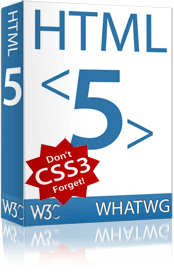W3C and WHATWG Provide HTML5 Updates
W3C
 The W3C is pretty good about posting news when new HTML/CSS-related documents undergo updates, status changes, or generally move forward. On Friday the W3C HTML Working Group announced the publication of eight new documents. The brief release provides an even briefer overview of each, or you can see the same list, with the ability to file a bug, at the HTML Working Group home page. The eight documents (all dated January 13, 2011):
The W3C is pretty good about posting news when new HTML/CSS-related documents undergo updates, status changes, or generally move forward. On Friday the W3C HTML Working Group announced the publication of eight new documents. The brief release provides an even briefer overview of each, or you can see the same list, with the ability to file a bug, at the HTML Working Group home page. The eight documents (all dated January 13, 2011):
- Working Draft of the HTML5 specification.
- An updated draft of the helpful HTML5 differences from HTML4.
- The accompanying non-normative HTML: The Markup Language Reference, which is worth reading through if only to look at the items marked changed.
- HTML+RDFa 1.1, which outlines support for RDFa in both HTML4 and HTML5.
- HTML Microdata, discussing support for machine-readable data in HTML, ideally in an easty-to-write manner.
- HTML Canvas 2D Context, which, I think obviously, defines the API for use with the
canvaselement. - HTML5: Techniques for providing useful text alternatives, a handy document for how to use the
altattribute and other related features (exceptlongdesc). - Polyglot Markup: HTML-Compatible XHTML Documents, intended to offer developers guidelines for creating HTML documents that validate as both HTML and XML. It’s worth a read just to understand the premise.
For those of you more interested in the progress of accessibility in HTML, you can always drop in to see the weekly W3C Accessibility Task Force (a11ytf) bugs which are just hanging out, waiting to be closed, verified, or sent along to the HTML Tracker. Laura Carlson (of the [webdev] Web Design Update newsletter) sends out a weekly email update with a link to the report, Pre-Last Call “A11ytf” Keyword Bugs Awaiting Task Force Action (these links are both from January 15, 2011).
WHATWG
WHATWG is trying something new — a summary. As the author writes, If this works out you might see another one.
There is a chance, then, that you might not see another. At least the document posted on January 16 gives us some updates for now. Read it at Base64, model trains, Web Workers & the DOM, captions, …
Unlike the W3C status update, this one is more casual. It links to emails flying around between the members, allowing you as the user to dive right into a thread and follow it along. It is not scrubbed or converted to non-technical language, so it provides a nice behind the scenes look. For example, there is a link to an email, [whatwg] Google Feedback on the HTML5 media a11y specifications, that provides feedback from Google on the HTML5 media accessibility specifications. As the folks who run YouTube, Google’s feedback is important to the success of video on the web, and so Google’s rep discusses things like the track element and the caption text file format. Don’t expect to see any references to codecs (like the Chrome/H.264 dust-up).
Bonus
Since reading this may have gotten you all excited over the specs and all things related to it, take a few minutes to read this post about a “Shadow Dom:” What the Heck is Shadow DOM? If you play at all with JavaScript (libraries or otherwise), you may be interested to read up on examples such as the new slider input element and how you can access the element within the input — but not via standard HTML/CSS selectors, only via script. After all, if you are implementing it, you will need script to make it do something, so leaving that to the client-side script makes sense as a developer.
There, now you have enough to keep you busy on what might otherwise be a slow Monday at work.
Leave a Comment or Response